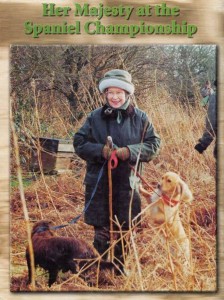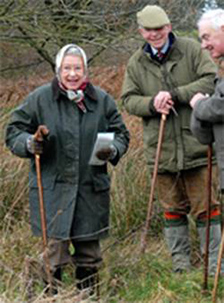Interview with David Lauber – Part I
(With permission. Originally published on www.gundogsonline.com)
David Lauber:
“As with every article I would like to offer a bit of reality to the training process and make one comment.”
 “The steadying process is not black and white. It’s filled with many gray areas that require a person with knowledge and experience. I have seen many dogs ruined by novice trainers because they lack the experience required to read the dog properly and apply the techniques outlined here. The steadying process, which I explain here, is only one approach. An entire book could be written to address all the issues you could run into during the steadying process and how to combat the “steadying blues”. When professionals train dogs they try many different approaches before they find an approach that works with a particular dog. A reputable professional can read a dog and avoid problems long before they actually occur. This is where the experience of professional trainers comes into play. By constantly refining their training program, professional trainers can often avoid the inevitable pitfalls novice run into when training a dog. A well thought out training program, built on experience, can often be the difference that makes or breaks a field trial champion and even a gun dog as we move into the advanced levels of training. With that said, let’s move on.”
“The steadying process is not black and white. It’s filled with many gray areas that require a person with knowledge and experience. I have seen many dogs ruined by novice trainers because they lack the experience required to read the dog properly and apply the techniques outlined here. The steadying process, which I explain here, is only one approach. An entire book could be written to address all the issues you could run into during the steadying process and how to combat the “steadying blues”. When professionals train dogs they try many different approaches before they find an approach that works with a particular dog. A reputable professional can read a dog and avoid problems long before they actually occur. This is where the experience of professional trainers comes into play. By constantly refining their training program, professional trainers can often avoid the inevitable pitfalls novice run into when training a dog. A well thought out training program, built on experience, can often be the difference that makes or breaks a field trial champion and even a gun dog as we move into the advanced levels of training. With that said, let’s move on.”
Gundogs Online:
“Last month we talked at length about developing a solid quartering pattern in the field with a spaniel. How long would you continue this pattern work before thinking about starting to steady the young spaniel?”
David Lauber:
“It depends on the dog. We typically look at the individual dog. If he has a bold, strong flush, chases and retrieves birds without any issues and he is doing everything we are asking him to do, we would consider steadying him. We place a high importance on a bold flush when making this decision to steady the dog. I would hold off on beginning the steadying process until the flush is as strong as it could be. It’s during this phase we can run into problems known as the “steadying blues”, where the dog’s flush will become weaker or slower. So, if he is not up to par with his flush I would hold off. In fact, I would much rather have a weak retrieve than a weak flush going into the steadying process.”
Gundogs Online:
“What would you do to enhance the dog’s flush? Are there any concepts you might try to really ‘jazz’ him up prior to entering the steadying process?”
David Lauber:
“Well Geoff, there are two ways to strength a dog’s flush. The first, as I alluded to last month, is to maintain a proper balance between clip wing birds and flyaway birds. Often, too many flyaway birds for a young dog will soften it’s flush. However, we can’t stay on clip wing birds for the dog’s entire career. So being able to read your dog and know what the proper balance is for that individual dog is the name of the game when it comes to developing a strong flush.”
“If the clip wing birds don’t do it, I like to use guinea hens to enhance the drive on birds. The nice thing about guinea hens, as opposed to pheasants, is that guinea hens will typically stay on the nest until the dog arrives, whereas a pheasant will typically run off, causing a young, inexperienced dog to ponder a bit when locating game. That’s not to say that pheasants aren’t important in the grand scheme of things, they’re just not as effective as guinea hens when you’re trying to develop a strong flush. The other added benefit of guinea hens is that they will typically run and flap their wings and make a god-awful cackle while being chased by a spaniel. This animation and noise works wonders with a young dog that may have a weak flush.”
Gundogs Online:
“How would you begin the steadying process?”
David Lauber:
“Well the first step is to put away the shotguns and head back to the yard. You can continue fieldwork (quartering / pattern work), however it is critical that your spaniel gets nothing but clip wing birds on the ground until you’re done with your yard work necessary for steadying. You do not want them seeing any birds being rolled in or in the air for that matter.”
“The approach I use for yard work when steadying a spaniel is a combination of two methods I learned from two different gentlemen. In the yard we have two poles anchored securely into the ground, approximately 20 yards apart (“hup poles”). I get myself a single piece of rope that can be wrapped completely around these two “hup poles” to rig-up a pulley system (see Diagram A). The rope should be wrapped completely around the two “hup poles” and secured to the puppy’s collar.”
David Lauber:
“The first step is to review “hup” with the young spaniel. You would place the dog in between the two poles while you stand about 3-5 yards away from him. Then hit the “hup” whistle, if he does not respond to the whistle immediately, give him a verbal reminder and a quick tug on the rope to force him backwards and into the sit position. The converse holds true as well, if I hit the recall whistle and he does not come to me, I can gently pull him towards me by using this pulley system. The reason I begin with simple commands like “hup” and “here” is so that the dog gets accustomed to this new apparatus.”
 “You can see how things build on themselves with this system. All along we have been using a check cord to correct retrieving issues and enforcing the “hup” and “here” commands. Now we are just adding one more item to the training process, the “hup poles”. At first the young dog might try to run away, but he has nowhere to go. The pulley system allows you to work on and enforce “remote hup” and “here” commands in the yard. Call him to you and hit the whistle (“here” then “hup”), repeat this over and over, until he reliably “hups” in the yard.”
“You can see how things build on themselves with this system. All along we have been using a check cord to correct retrieving issues and enforcing the “hup” and “here” commands. Now we are just adding one more item to the training process, the “hup poles”. At first the young dog might try to run away, but he has nowhere to go. The pulley system allows you to work on and enforce “remote hup” and “here” commands in the yard. Call him to you and hit the whistle (“here” then “hup”), repeat this over and over, until he reliably “hups” in the yard.”
Gundogs Online:
“Is it at this point that you test without the “hup poles”?”
David Lauber:
“Once he seems to be reliable in the yard on the “hup poles”, I will test him by hitting the “hup” whistle as I am leaving him as we walk back to the kennel. If he does not “hup” immediately and tries to come toward me, I would pick him up and put him back where he was when I gave him the command. I don’t punish him.”
“Once they seem to prove themselves and respond to “hup” on the way back to the kennel, I would take the dummies back out during the next session and go back to the yard. This time I will disconnect the rope so it’s only wrapped around one pole. Again, I position myself in front of the dog while I hold the other end of the rope in one hand and toss the dummy over my shoulder. The key here is that I am between the dog and the dummy. By holding onto the rope tightly, I will be able to prevent the dog from breaking as I throw the dummy. Once the dummy hits the ground I give the dog a release command and let go of the rope so he can make the retrieve. Then set up again and continue until you don’t need the rope around the pole to prevent the dog from breaking.”
“Once the dog has the idea that he needs to sit before being sent for the retrieve while on the “hup poles” with me blocking his path, I take him off the “hup poles” and slap a check cord on him. I start by positioning the dog by my side and throw a dummy in front of him. I have the other end of the check cord in my hand in case he attempts to break I could quickly correct him before sending him for the retrieve. This increases the temptation for the dog to break, while teaching him that even though there is nothing blocking him, he has to wait to be sent.”
Gundogs Online:
“Do you allow slack in the rope when you’re doing this or is the rope taunt?”
David Lauber:
“I make sure I allow some slack in the rope so the dog has the choice whether or not he is going to break. If the rope is taunt, he will inevitably keep his butt on the ground. We are looking to see if the steadying concept is sinking in or not. If the rope is slack and the dog remains sitting until released, I can feel fairly comfortable that he understands the concept.”
Gundogs Online:
“Should you vary the interval of time between the amount of time you throw the dummy and when you send the dog?”
David Lauber:
“When you first start teaching the concept, you do not need to be concerned with changing the cadence of your release command. Your goal should be on teaching him to wait for you to send him before making the retrieve. Once he understands that he needs to wait to make the retrieve, start to change the timing. Otherwise, he will start to anticipate your release command and leave a bit early. By constantly mixing it up, he will get the idea that he has to wait for the release command before making the retrieve. If you start to see him waiting for say the count of 3 then leaving, its time to mix it up and send him on a count of 5 instead. Make sure you are always changing the count before sending him; otherwise he will start leaving early.”
“Next issue, we will talk about introducing your spaniel to birds in the steadying process and we will talk about the transition to the field. Until then, have fun!”



